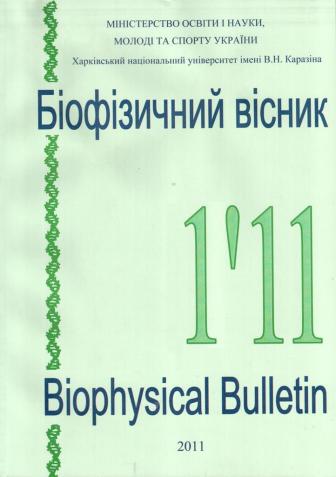Са2+ механізм активації гемолізу, викликаного літичним поліпептидом еквінатоксином ii
Анотація
Еквінатоксін II – цитолітичний поліпептид морської анемони Actinia equina L., який утворює пори
в природних і штучних мембранах. У даній роботі ми показуємо, що механізм, за яким Ca2+активує токсин-індукований гемоліз еритроцитів людини, полягає у здатності Ca2+ проникати вклітку ймовірно через заздалегідь утворені токсином пори і викликати усередині клітки збільшення швидкості зв’язування токсину з мембраною. В результаті утворюється більша кількість пор, що і збільшує швидкість гемолізу. Крім того дані показують, що еквінатоксин II викликає гемоліз еритроцитів, взаємодіючи з обмеженою кількістю місць зв’язування токсину (рецепторів) з щонайбільш (180 35) 103 місць на одну клітину. Загальна кількість місць звязування токсину не залежить від присутності Ca2+. Ці дані переконливо свідчать, що на еритроцитарній мембрані повинні існувати специфічні рецептори, які опосередковують гемолітичну дію цього токсину.
Завантаження
Посилання
2. Belmonte G, Pederzolli C, Macek P, Menestrina G. Pore formation by the sea anemone cytolysin equinatoxin II in red blood cells and model lipid membranes. J.Membr.Biol. 1993;131(1):11-22.
3. Bunc M, Drevensek G, Budihna M, Suput D. Effects of equinatoxin II from Actinia equina (L.) on isolated rat heart: the role of direct cardiotoxic effects in equinatoxin II lethality. Toxicon 1999;37(1):109-23.
4. Frangez R, Meunier F, Molgo J, Suput D. Equinatoxin II increases intracellular Ca2+ in NG 108-15 cells. Pflugers Arch. 2000;439(3 Suppl):R100-R101.
5. Hewlett EL, Gray L, Allietta M, Ehrmann I, Gordon VM, Gray MC. Adenylate cyclase toxin from Bordetella pertussis. Conformational change associated with toxin activity. J.Biol.Chem. 1991;266(26):17503-8.
6. Hoffman JF. On the mechanism and measurement of shape transformations of constant volume of human red blood cells. Blood Cells 1987;12(3):565-88.
7. Lafranconi WM, Ferlan I, Russell FE, Huxtable RJ. The action of equinatoxin, a peptide from the venom of the sea anemone, Actinia equina, on the isolated lung. Toxicon 1984;22(3):347-52.
8. Macek P, Belmonte G, Pederzolli C, Menestrina G. Mechanism of action of equinatoxin II, a cytolysin from the sea anemone Actinia equina L. belonging to the family of actinoporins. Toxicology 1994;87(1-3):205-27.
9. Macek P, Lebez D. Kinetics of hemolysis induced by equinatoxin, a cytolytic toxin from the sea anemone Actinia equina. Effect of some ions and pH. Toxicon 1981;19(2):233-40.
10. Mally M, Majhenc J, Svetina S, Zeks B. Mechanisms of equinatoxin II-induced transport through the membrane of a giant phospholipid vesicle. Biophys.J. 2002;83(2):944-53.
11. Menestrina G, Schiavo G, Montecucco C. Molecular mechanisms of action of bacterial protein toxins. Mol.Aspects.Med. 1994;15(2):79-193.
12. Pasternak CA, Alder GM, Bashford CL, Buckley CD, Micklem KJ, Patel K. Cell damage by viruses, toxins and complement: common features of pore-formation and its inhibition by Ca2+. Biochem.Soc.Symp. 1985a;50:247-64.
13. Pasternak CA, Alder GM, Bashford CL, Buckley CD, Micklem KJ, Patel K. Cell damage by viruses, toxins and complement: common features of pore-formation and its inhibition by Ca2+. Biochem.Soc.Symp. 1985b;50:247-64.
14. Portlock SH, Clague MJ, Cherry RJ. Leakage of internal markers from erythrocytes and lipid vesicles induced by melittin, gramicidin S and alamethicin: a comparative study. Biochim.Biophys.Acta 1990;1030(1):1-10.
15. Rudenko SV, Nipot EE. Protection by chlorpromazine, albumin and bivalent cations against haemolysis induced by melittin, [Ala-14]melittin and whole bee venom. Biochem.J. 1996;317 ( Pt 3):747-54.
16. Teng CM, Lee LG, Lee CY, Ferlan I. Platelet aggregation induced by equinatoxin. Thromb.Res. 1988;52(5):401-11.
17. Zorec R, Tester M, Macek P, Mason WT. Cytotoxicity of equinatoxin II from the sea anemone Actinia equina involves ion channel formation and an increase in intracellular calcium activity. J.Membr.Biol. 1990;118(3):243-9.
Автори, які публікуються у цьому журналі, погоджуються з наступними умовами:
- Автори залишають за собою право на авторство своєї роботи та передають журналу право першої публікації цієї роботи на умовах ліцензії Creative Commons Attribution License, котра дозволяє іншим особам вільно розповсюджувати опубліковану роботу з обов'язковим посиланням на авторів оригінальної роботи та першу публікацію роботи у цьому журналі.
- Автори мають право укладати самостійні додаткові угоди щодо неексклюзивного розповсюдження роботи у тому вигляді, в якому вона була опублікована цим журналом (наприклад, розміщувати роботу в електронному сховищі установи або публікувати у складі монографії), за умови збереження посилання на першу публікацію роботи у цьому журналі.
- Політика журналу дозволяє і заохочує розміщення авторами в мережі Інтернет (наприклад, у сховищах установ або на особистих веб-сайтах) рукопису роботи, як до подання цього рукопису до редакції, так і під час його редакційного опрацювання, оскільки це сприяє виникненню продуктивної наукової дискусії та позитивно позначається на оперативності та динаміці цитування опублікованої роботи (див. The Effect of Open Access).





